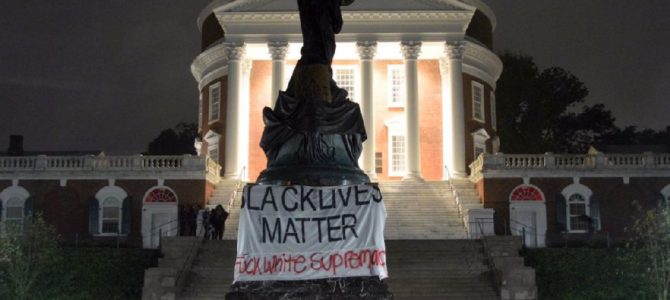Mostly lost in the general hysteria surrounding President Trump’s post-Charlottesville press conference a month ago was an excellent question he posed. Regarding the growing demand nationwide to tear down monuments to the Confederate States of America, he asked: “I wonder, is it George Washington next week? And is it Thomas Jefferson the week after? You know, you really do have to ask yourself, where does it stop?”
His remarks were characterized by historians as “absurd” and “unacceptable” and “ignorant” and dismissed as a “red herring.” At The Daily Beast, John Avlon called Trump’s comparison “immoral” and “dangerous.” At Slate, Jamelle Bouie claimed Trump’s question was “dumb,” arguing that statues of Washington and Jefferson were safe because “the reason we memorialize them is not because of their slaveholding.”
Well. Earlier this week around 100 “students, faculty and community members” gathered at of the University of Virginia and “[covered] a statue of Thomas Jefferson in a black shroud…adorning it with signs that dubbed the former president a ‘racist’ and ‘rapist.’” The protesters derided the statue as “an emblem of white supremacy,” and demanded that it be “re-contextualized,” lambasting the people who “fetishize the legacy of Jefferson,” calling on the community to “recognize Jefferson as a rapist, racist, and slave owner.”
Where does it stop? It is perhaps asking a bit much of our progressive friends to reflect on their slapdash dismissal of President Trump’s reasonable question. It was a month ago, after all, and there have been plenty of fresh outrages to geek out over since then. Just the same: where does it stop? That is not an unfair question; in fact it is a presciently vital one.
Four weeks ago everyone knew that Trump’s simple and logical question was “dumb.” This week a bunch of protesters, among them faculty on the payroll of the institution they were tacitly vandalizing, wound a statue of Jefferson in a makeshift burial shroud and—what was the term again?—“memorialized him for his slaveholding.”
Where does it stop? Not here, obviously. The mob at UVA did not issue a demand to tear down the statues of Jefferson. But they surely will, probably sooner rather than later. And why shouldn’t they? It has worked in countless other cities and on numerous other campuses. Stockton University recently removed a bust of its namesake founder due to his slaveholding past, while earlier this year Pepperdine University tore down a statue of Christopher Columbus because the statue was, allegedly “a celebration of genocide and racial oppression.”
The University of Virginia tends to regard itself with a bit more esteem than your average public university, so it may hold out longer than other colleges. But for how long? UVA president Theresa Sullivan, for one, issued an almost too-tepid-to-be-true response to the vandalism, claiming she “strongly disagree[s] with the protestors’ decision to cover the Jefferson statue,” but conceding: “That there is…activism [at UVA] should not be a surprise to any of us.”
This is not the voice of a confident administrator, and if I were a betting man, I would place a small but not insubstantial amount of money on protestors getting the statue down at some point. When you start hanging signs on a monument that read “rapist” and “racist,” it’s only a matter of time before you start calling for the monument itself to go.
All of which is to say that Trump was right to ask his question, and his critics—histrionic, hysterical, unwilling to acknowledge just how unhinged activist progressivism has become in twenty-first-century America—were wrong. Of course they’re going to come for the other statues; that was a given. Whether they succeed in tearing them down depends on the resolve and the integrity of the people who are in charge of such decisions. “Where does it stop?” We’ll surely find out soon enough, one way or the other.








